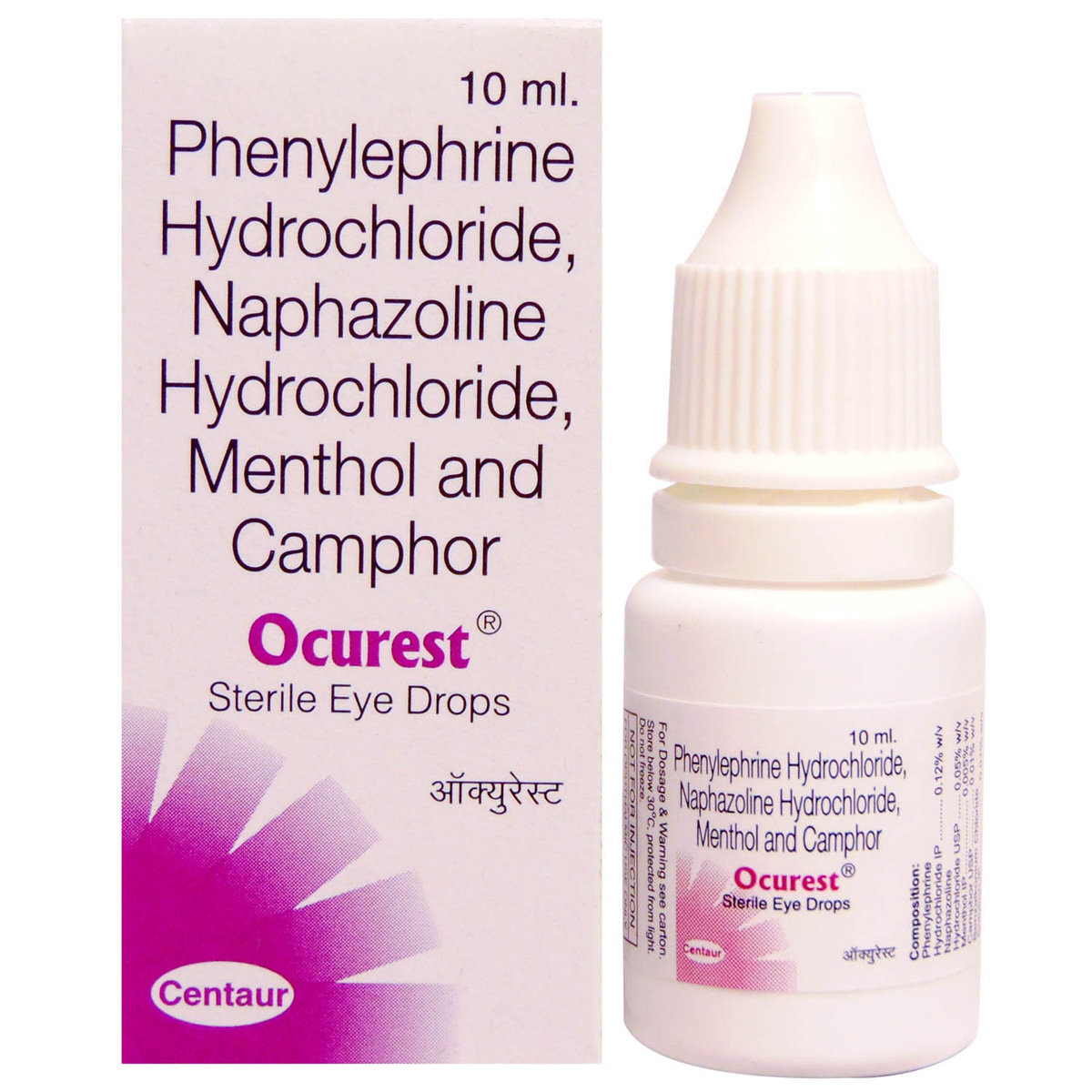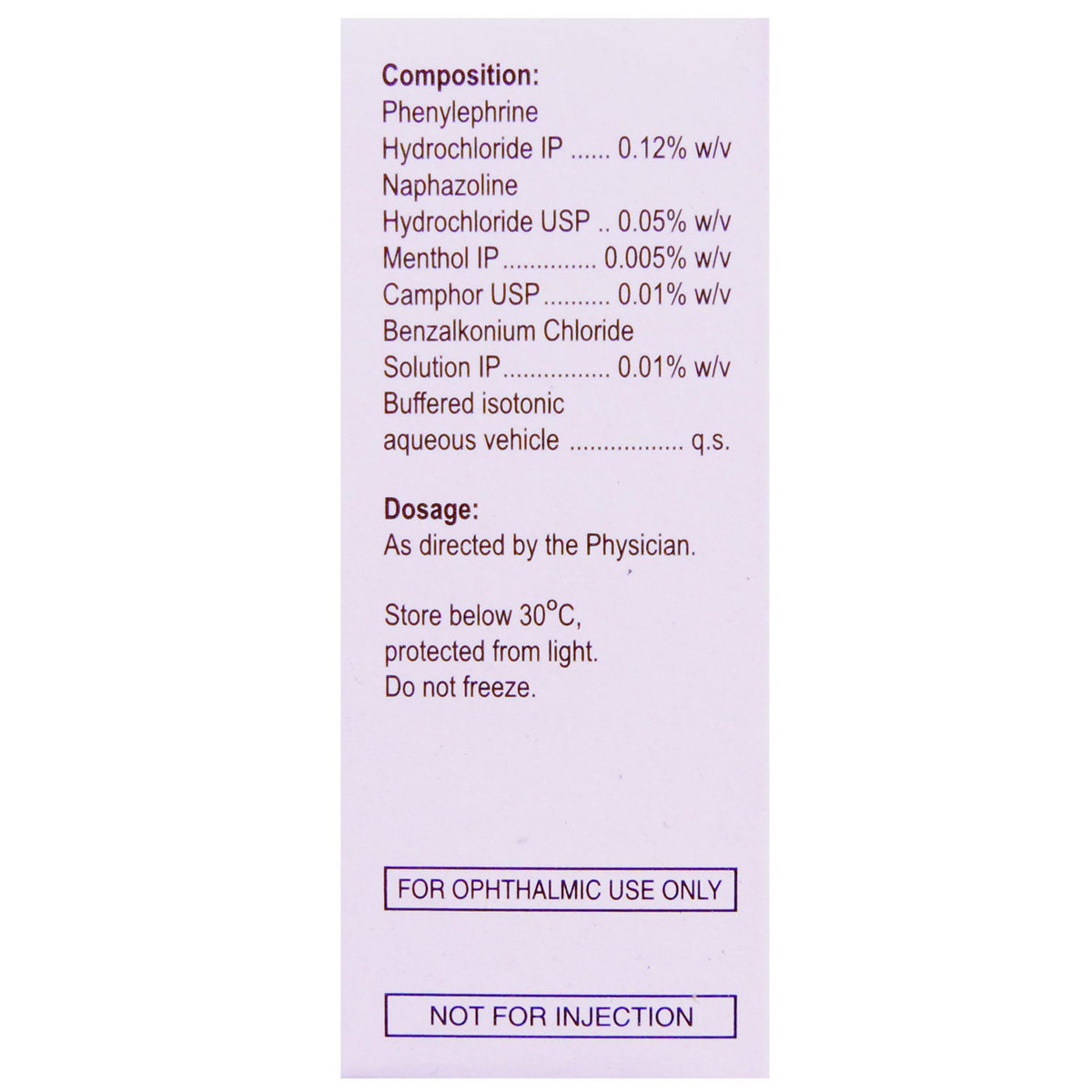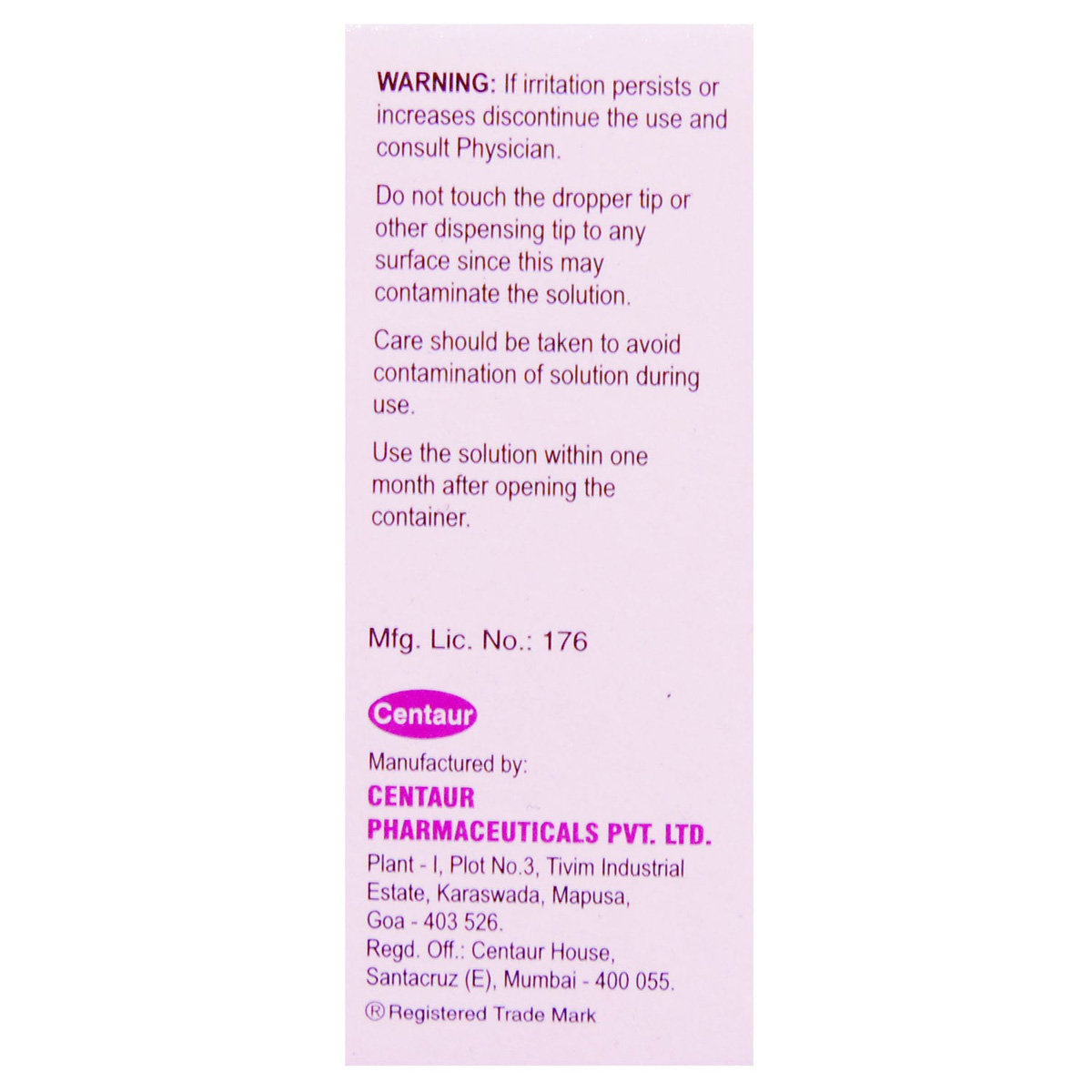Ocurest Eye Drops 10 ml






MRP ₹109.5
(Inclusive of all Taxes)
₹16.4 Cashback (15%)
Provide Delivery Location
Online payment accepted
 Prescription drug
Prescription drugWhats That
Manufacturer/Marketer :
Consume Type :
Expires on or after :
Return Policy :
About Ocurest Eye Drops
Ocurest Eye Drops is a combination medicine indicated for providing temporary relief from congestion and discomfort associated with minor eye irritation due to dust, hay fever, smoke, cold, sun, swimming, or smog. It is used to treat allergic conjunctivitis (eye allergy), vernal conjunctivitis (swelling of the outer lining of the eyes), phlyctenular conjunctivitis (inflammation of the cornea and conjunctiva), and dry eye syndrome.
Ocurest Eye Drops contains Phenylephrine hydrochloride, Naphazoline hydrochloride, Camphor, Menthol, and Benzalkonium chloride. Phenylephrine hydrochloride and naphazoline hydrochloride work by constricting/narrowing the blood vessels of the eye; this helps in providing relief from itching and irritation. Camphor and menthol help in providing a cooling sensation to the eye. Benzalkonium chloride acts as a preservative. Together, Ocurest Eye Drops helps in providing relief from an eye allergy and dry eye syndrome.
Ocurest Eye Drops is for ophthalmic (eye) use only. You are advised to use Ocurest Eye Drops for as long as your doctor has prescribed it for you depending on your medical condition. In some cases, Ocurest Eye Drops may cause certain common side-effects such as pain, irritation, blurred vision and stinging sensation. Most of these side effects do not require medical attention and will resolve gradually over time. However, you are advised to talk to your doctor if the side effects persist or worsen.
Talk to your doctor if the irritation persists despite using Ocurest Eye Drops for a week or if it worsens. Consult your doctor if you are pregnant or breastfeeding. Ocurest Eye Drops should not be used in children unless prescribed by the doctor. Do not touch the tip of the dropper to the eye, eyelids, and surrounding areas, as it may contaminate the solution. Inform your doctor regarding other prescription, non-prescription and herbal medicines you are taking to prevent any side effects/interactions.
Uses of Ocurest Eye Drops
Directions for Use
Key Benefits
Ocurest Eye Drops is indicated for providing temporary relief from congestion and discomfort associated with minor eye irritation due to dust, hay fever, smoke, cold, sun, swimming, or smog. It is used to treat allergic conjunctivitis (eye allergy), vernal conjunctivitis (swelling of the outer lining of the eyes), phlyctenular conjunctivitis (inflammation of the cornea and conjunctiva), ocular itching, redness, tearing, and dry eye syndrome. Ocurest Eye Drops contains Phenylephrine hydrochloride, Naphazoline hydrochloride, Camphor, Menthol, and Benzalkonium chloride. Phenylephrine hydrochloride and naphazoline hydrochloride are decongestants that work by constricting/narrowing the blood vessels of the eye; this helps in providing relief from itching and irritation. Camphor and menthol help in providing a cooling sensation to the eye. Benzalkonium chloride acts as a preservative. Together, Ocurest Eye Drops helps in providing relief from an eye allergy.
Storage
Drug Warnings
Do not use Ocurest Eye Drops if you are allergic to any of its contents. Inform your doctor if you are taking monoamine oxidase inhibitors or have taken them in the last few weeks, if you have closed-angle glaucoma, high blood pressure, diabetes, eye infection or injury, hyperthyroidism, heart, kidney or liver problems. Consult your doctor if you are pregnant or breastfeeding. Ocurest Eye Drops should be used in children only if prescribed by the doctor.
Drug-Drug Interactions
Drug-Drug Interactions
Login/Sign Up
Taking Ocurest Drops 10ml *** with Propofol may lead to increased levels of Ocurest Drops 10ml *** leading to side effects like high blood pressure.
How to manage the interaction:
Taking Ocurest Drops 10ml *** with Propofol is not recommended, but it can be taken if prescribed by the doctor. Do not discontinue the medications without consulting a doctor.
Taking Furazolidone with Ocurest Drops 10ml *** can cause an increase in high blood pressure.
How to manage the interaction:
Taking Furazolidone with Ocurest Drops 10ml *** is not recommended, it can be taken if prescribed by the doctor. However, if you experience sudden and severe headache, blurred vision, confusion, seizures, chest pain, nausea or vomiting, sweating, lightheadedness, fainting, sudden numbness or weakness (especially on one side of the body), speech difficulties, fever, consult the doctor immediately. It is advised to use Ocurest Drops 10ml *** only after 14 days of stopping Furazolidone.
Co-administration of Ocurest Drops 10ml *** with Sevoflurane can increase the levels of Ocurest Drops 10ml *** and lead to side effects.
How to manage the interaction:
Taking Ocurest Drops 10ml *** with Sevoflurane is not recommended, it can be taken if prescribed by the doctor. Do not discontinue the medications without consulting a doctor.
Taking Tranylcypromine with Ocurest Drops 10ml *** can increase the risk of high blood pressure.
How to manage the interaction:
Taking Tranylcypromine with Ocurest Drops 10ml *** is not recommended, but can be taken together if prescribed by a doctor. However, consult a doctor if you experience severe headache, blurred vision, confusion, seizures, chest pain, nausea or vomiting, sudden numbness or weakness (especially on one side of the body), speech difficulties, fever, sweating, lightheadedness, and fainting Do not discontinue any medications without consulting a doctor.
Co-administration of Selegiline with Ocurest Drops 10ml *** together can raise blood pressure.
How to manage the interaction:
Taking Selegiline with Ocurest Drops 10ml *** is not recommended, it can be taken together if prescribed by a doctor. However, consult a doctor immediately if you experience any symptoms such as severe headache, blurred vision, confusion, fits, chest pain, nausea or vomiting, sudden numbness or weakness (especially on one side of the body), speech difficulties, fever, sweating, lightheadedness, and/or fainting Do not discontinue any medications without consulting a doctor.
Co-administration of Topiramate can cause increased body temperature and decreased sweating, and these effects may be worsened when combined with medications like Ocurest Drops 10ml ***.
How to manage the interaction:
Although there is a possible interaction between Ocurest Drops 10ml *** and Topiramate, you can take these medicines together if prescribed by your doctor. However, if you experience any unusual symptoms, consult the doctor. Do not discontinue any medications without consulting a doctor.
Co-administration of Ocurest Drops 10ml *** with Halothane may increase the risk of an irregular heart rhythm.
How to manage the interaction:
Although taking Ocurest Drops 10ml *** with Halothane together can result in an interaction, it can be taken if a doctor has prescribed it. However, if you experience any symptoms like lightheadedness, fainting, irregular heart beat, dizziness, consult the doctor. Do not discontinue any medications without a doctor's advice.
Co-administration of Nortriptyline with Ocurest Drops 10ml *** may lead to side effects like increased blood pressure.
How to manage the interaction:
Although taking Nortriptyline and Ocurest Drops 10ml *** together can result in an interaction, it can be taken if a doctor has prescribed it. Regular monitoring of blood pressure is advised. Do not discontinue any medications without a doctor's advice.
Co-administration of Amoxapine and Ocurest Drops 10ml *** together may lead to side effects like increased blood pressure.
How to manage the interaction:
Taking Ocurest Drops 10ml *** and Amoxapine together can result in an interaction, it can be taken if a doctor has advised it. However, if you experience any unusual symptoms, consult the doctor. It is advised to maintain blood pressure. Do not discontinue any medications without a doctor's advice.
Co-administration of Ocurest Drops 10ml *** with Phenelzine can result in extremely high blood pressure which may be serious.
How to manage the interaction:
There may be a possibility of interaction between Ocurest Drops 10ml *** and Phenelzine, but it can be taken if prescribed by a doctor. However, If you develop a sudden, severe headache, blurred vision, confusion, chest pain, nausea, vomiting, sudden numbness or weakness (particularly on one side of the body), difficulty speaking, fever, sweating, lightheadedness, or fainting, consult a doctor immediately. Do not stop using any medications without a doctor's advice.
Drug-Food Interactions
Drug-Food Interactions
Login/Sign Up
Diet & Lifestyle Advise
- Wash your hands regularly. Avoid touching the eyes with dirty hands.
- Avoid rubbing the eyes.
- Avoid sharing eye makeup such as eyeliner, mascara or kohl.
- Always use clean towels or tissues to wipe your eyes and face.
- Regularly wash and change the pillow cases.
- If you wear contact lens: Clean and replace contact lens more often. Never share contact lens. Always remember to wash your hands before inserting and after removing the contact lens.
- Avoid staring at digital screens for longer durations. Rest your eyes every 20 minutes.
- Blink regularly as it helps in the spread of hydrating substances such as mucus and tears across the eyes.
Side Effects of Ocurest Eye Drops
- Pain
- Irritation
- Stinging sensation
- Blurred vision
Habit Forming
Therapeutic Class
All Substitutes & Brand Comparisons
Author Details
We provide you with authentic, trustworthy and relevant information
Drug-Diseases Interactions
Drug-Diseases Interactions
Login/Sign Up
FAQs
Ocurest Eye Drops works by constricting/narrowing the blood vessels of the eye; this helps in providing relief from itching and irritation. It also helps in providing a cooling sensation to the eye.
To treat your condition effectually, continue using Ocurest Eye Drops for as long as your doctor has prescribed it. Consult the doctor if the irritation persists or worsens despite using Ocurest Eye Drops for a week.
Ocurest Eye Drops might temporarily blur your vision. So, do not drive or operate machinery until your vision is clear to prevent any mishappening.
Do not wear contact lens while using Ocurest Eye Drops. Remove contact lenses before using Ocurest Eye Drops and reinsert after 15 minutes of using Ocurest Eye Drops.
Ocurest Eye Drops can be used with other eye medications if prescribed by the doctor. Maintain a gap of 10-15minutes between Ocurest Eye Drops and other eye medications.
Disease/Condition Glossary
Allergic conjunctivitis (Eye allergy): Allergic conjunctivitis, also known as eye allergy is the immune response that occurs when the eye comes in contact with an irritating substance known as an allergen. Symptoms of eye allergy include itching, burning sensation, watery eyes, red/pink eyes, scaling around the eyes, and swollen or puffy eyelids.
Dry eyes: Dry eye is a common eye condition that occurs when your tears cannot provide ample lubrication for the eyes. The tearing instability leads to inflammation and damage to the eye surface. The dry eye could be caused by disruption of the healthy tear film due to autoimmune disease, hormonal changes, or inflamed eyelid glands. Symptoms include burning sensation, sensitivity to light, eye redness, a sensation of having something in the eyes, watery eyes, and blurred vision.

Have a query?
Buy best Ocular products by
Entod Pharmaceuticals Ltd
Ajanta Pharma Ltd
Sunways (India) Pvt Ltd
Sun Pharmaceutical Industries Ltd
Cipla Ltd
Micro Labs Ltd
Allergan Healthcare India Pvt Ltd
Intas Pharmaceuticals Ltd
Raymed Pharmaceuticals Ltd
Nri Vision Care India Ltd
FDC Ltd
Jawa Pharmaceuticals India Pvt Ltd
Indoco Remedies Ltd
Sapient Laboratories Pvt Ltd
Senses Pharmaceuticals Pvt Ltd
Centaur Pharmaceuticals Pvt Ltd
Neomedix Healthcare India Pvt Ltd
Aromed Pharmaceuticals
Optho Remedies Pvt Ltd
Aurolab
Austrak Pvt Ltd
Lupin Ltd
Mankind Pharma Pvt Ltd
Zivira Labs Pvt Ltd
Optho Pharma Pvt Ltd
Synovia Life Sciences Pvt Ltd
Akumentis Healthcare Ltd
Eyekare
His Eyeness Ophthalmics Pvt Ltd
Protech Remedies Pvt Ltd
Runyon Pharmaceutical Pvt Ltd
Alcon Laboratories Inc
Syntho Pharmaceuticals Pvt Ltd
Alembic Pharmaceuticals Ltd
Bell Pharma Pvt Ltd
Klar Sehen Pvt Ltd
Sentiss Pharma Pvt Ltd
Irx Pharmaceuticals Pvt Ltd
Optho Life Sciences Pvt Ltd
Phoenix Remedies Pvt Ltd
Alkem Laboratories Ltd
Doctor Wonder Pvt Ltd
Hicare Pharma
Ipca Laboratories Ltd
Neon Laboratories Ltd
Okulus Drugs India
Pharmtak Ophthalmics (I) Pvt Ltd
Berry & Herbs Pharma Pvt Ltd
Glow Vision Pharmaceuticals
Kaizen Drugs Pvt Ltd
Choroid Laboratories Pvt Ltd
Indiana Opthalamics Pvt Ltd
Optica Pharmaceutical Pvt Ltd
Pharmatak Opthalmics India Pvt Ltd
Samarth Life Sciences Pvt Ltd
Vibgyor Vision Care
Mofon Drugs
Novartis India Ltd
Pharmia Biogenesis Pvt Ltd
Zydus Cadila
Appasamy Ocular Devices Pvt Ltd
Leeford Healthcare Ltd
Medivision Pharma Pvt Ltd
Orbit Life Science Pvt Ltd
X-Med Royal Pharma Pvt Ltd
Zee Laboratories Ltd
Aarma Laboratories
Guerison MS Inc
Laborate Pharmaceuticals India Ltd
Xtas Pharmaceuticals
Accurex Biomedical Pvt Ltd
Blucrab Pharma Pvt Ltd
Does Health Systems Pvt Ltd
Flagship Biotech International Pvt Ltd
Lavue Pharmaceuticals Pvt Ltd
Nutrilis Healthcare Pvt Ltd
Ursa Pharm India Pvt Ltd
Vee Remedies
Vyonics Health Care India Pvt Ltd
Warren Pharmaceuticals Pvt Ltd
Abbott India Ltd
Accvus Pharmaceuticals
Akums Drugs & Pharmaceuticals Ltd
Cadila Healthcare Ltd
Carevision Pharmaceuticals Pvt Ltd
Dey's Medical Stores (Mfg) Ltd
East West Pharma India Pvt Ltd
Eyedea Pharmaceuticals Pvt Ltd
Nimbus Healthcare Pvt Ltd
Ocuris Pharmaceuticals Pvt Ltd
Sherings Pharmaceuticals
Tarks Pharmaceuticals Pvt Ltd
Vcan Biotech
Vision Medilink
Aice Health Care Pvt Ltd
Appasamy Pharmaceuticals Pvt Ltd
Asperia Lifescience Pvt Ltd
Beatum Healthcare Pvt Ltd
East India Pharmaceutical Works Ltd
Grevis Pharmaceutical Pvt Ltd
Alcohol
Safe if prescribed
It is not known whether Ocurest Eye Drops interacts with alcohol. Please consult your doctor.
Pregnancy
Consult your doctor
Please consult your doctor if you have any concerns regarding this; your doctor will prescribe only if the benefits outweigh the risks.
Breast Feeding
Consult your doctor
Please consult your doctor if you have any concerns regarding this; your doctor will decide whether Ocurest Eye Drops can be used by breastfeeding mothers or not.
Driving
Safe if prescribed
Ocurest Eye Drops may temporarily blur your vision. So, avoid driving or operating machinery until your vision is clear.
Liver
Consult your doctor
Limited data is available regarding the usage of Ocurest Eye Drops in patients with liver impairment. Please consult your doctor.
Kidney
Consult your doctor
Limited data is available regarding the usage of Ocurest Eye Drops in patients with kidney impairment. Please consult your doctor.
Children
Safe if prescribed
Ocurest Eye Drops should be used with caution in children. Ocurest Eye Drops should be administered in children only if prescribed by the doctor.



_0.jpg?tr=q-85)

